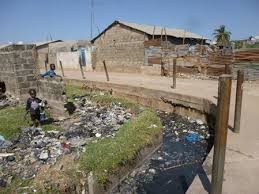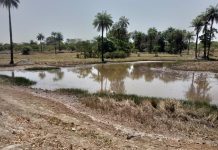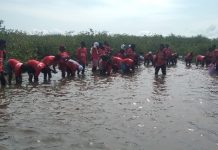By Nelson Manneh
Inthe densely populated communities that border the country’s wetlands—from Ebo-Town and New Jeshwang to Tallinding Farokono—residents are grappling with an invisible public health situation. As the rainy season nears, anxiety mounts.
Overflowing gutters, filled with solid waste and stagnant water, are now breeding grounds for bacteria, viruses, and disease-carrying insects. Health experts and residents alike say these neglected waterways pose serious threats to public health, ranging from cholera and dysentery to respiratory complications triggered by mould and decaying waste.
“Look at the drainages—they are jam-packed with solid waste,” said Lamin Fadera, a native of New Jeshwang. “How can water flow easily from one place to another? I don’t think the authorities should be absolutely blamed for this. The communities are part of the problem. The only way we can achieve progress is when the Anti-Littering Act is fully implemented.”
Fadera and others accuse the government of contributing to the crisis by constructing drainage systems that are never maintained. Many of these channels are now clogged, halting the natural flow of water from upland areas to the wetlands. But residents also admit that they are part of the problem—throwing household waste into open drains and failing to take responsibility for their upkeep.
According to health researchers, blocked drains not only cause flooding and property damage but also create ideal conditions for disease. Sewage spills can introduce harmful microorganisms into the environment, while stagnant water breeds mosquitoes, flies, and other vectors. Mould spores from damp environments aggravate allergies and respiratory illnesses, especially in people with asthma.
“Unclean drainages pose significant threats to public health by creating breeding grounds for disease vectors and contaminating water sources,” said Frances Camara, a public health officer. “Stagnant water in clogged drains can harbour bacteria and pathogens, leading to illnesses like cholera, dysentery, and other waterborne diseases. Furthermore, poor drainage can exacerbate flooding, leading to injuries from submerged debris or electrical hazards.”
Camara said the looming rainy season could make matters worse. “Wherever there is stagnant water, insects like mosquitoes breed. That’s a serious health threat. The government should make sure that gutters are regularly kept clean so water can flow smoothly to its final destination,” he said.
He also warned that unclean drainage systems can carry pollutants and chemicals into rivers and streams, affecting not only aquatic life but also human drinking water sources. Poor drainage, he added, can lead to soil erosion and degradation, ultimately threatening agriculture and food security.
Public health officer Fatou Marong underscored the widespread risks. “Untreated wastewater and contaminated stormwater runoff can carry pathogens like bacteria and viruses that cause diarrhoea, dysentery, cholera, and other illnesses,” she said. “Stagnant water in clogged drains becomes a breeding ground for mosquitoes, flies, and other insects that transmit diseases like malaria, dengue fever, and West Nile virus.”
Contact with contaminated water, she explained, can cause skin infections, allergic reactions, and other health problems. She also warned of the presence of sewage, industrial waste, and agricultural runoff in unclean drains, which can introduce harmful chemicals and heavy metals into the environment—sometimes making their way into the food chain.
“Inadequate sanitation and contaminated water sources are major contributors to cholera outbreaks, particularly in areas with poor infrastructure,” Marong said. Diarrhoea, vomiting, and other gastrointestinal issues are common health problems associated with exposure to pathogens in unclean drainage systems. Skin rashes, itchiness, and allergic reactions can result from contact with contaminated drainage water or mould growth in damp areas.”
Beyond physical health, the psychological toll is also mounting. “The unpleasant odours and unsanitary conditions cause stress and anxiety,” said Louie Mendy, a resident of Jeshwang. “It affects our mental well-being. It’s hard to live with dignity when your surroundings are filled with filth and disease.”
Mendy emphasised that managing drainage systems effectively requires more than construction—it needs consistent maintenance, proper grading, and public education. “Key aspects include preventing blockages, ensuring adequate slope for water flow, and possibly using controlled drainage techniques to manage water levels,” he said.
Experts are calling for a multi-pronged response: regular drain cleaning, community participation, stricter enforcement of environmental laws, and greater investment in sanitation infrastructure. Marong said public education campaigns are crucial to change behaviour at the grassroots level.
“Investing in and maintaining proper sanitation and wastewater treatment systems is crucial to prevent contamination of water sources and reduce disease transmission,” she said.“Implementing effective stormwater management practices, such as proper drainage and erosion control, can minimise the risk of pollutants entering water bodies. And we must educate the public about hygiene, sanitation, and the dangers of unclean drainage to encourage responsible behaviour.”
Inneighbourhoodss like Tallinding Farokono, where heavy rains often submerge roads and seep into homes, the stakes could not be higher. With the clouds gathering and the first drops of the season imminent, residents wait—and worry. Without swift action, what begins as blocked gutters could end in a preventable health catastrophe.
| ReplyReply allForwardYou received this via BCC, so you can’t react with an emoji |



















